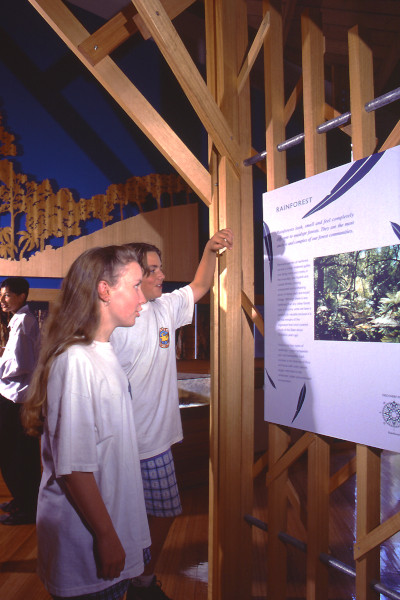The Forest Education Project
M Leonard
In the decades that followed the Second World War, urbanisation across south-eastern Australia continued apace. By the mid-1960s it was becoming increasing clear within sections of the Victorian Forest Service (the FCV) that with urbanisation, among other things, came a growing disconnect between citizens and the third of the State that comprised publicly-owned forests and woodlands.
The FCV, both within Melbourne and regionally, was responding to a small, but growing demand for ‘speakers’ to address school and, less frequently, tertiary student groups about aspects of the care and management of forest ecosystems. There was also emerging a small, but growing demand to assist with related field visits. Most units within the FCV welcomed these approaches, and attempted to accommodate them.
As part of an evolving, more general interface with the wider community, a Melbourne-based Forest Environment and Recreation Branch was established in 1971 and, in time, related specialist positions started to be designated in some Districts and Divisions. The Branch, and the related regional positions, had included in their responsibilities ‘community education’ roles.
Meanwhile, and as was perhaps surprisingly the case, certainly in my experience, from the mid-1970s at least, District Foresters appeared to have quite a degree of autonomy in terms of day-to-day operations, and in priority setting. Such was the case, for example, in a few Forest Districts immediately to the east of Melbourne. Districts headquartered at Kallista, Powelltown, Alexandra, and to an extent Marysville, were developing innovative ways of meeting what was becoming a growing community demand for forest-related educational experiences. By the late 1970s, the trailblazer was Toolangi District under the leadership of Rod Incoll. The Toolangi District had advantages that included being on Melbourne’s eastern fringe, and it geographically straddled the Great Dividing Range and therefore contained a range of forest ecosystems, including majestic Mountain Ash forests. At the Toolangi Depot a fire tanker shed had become an interchangeable lecture room, complete with a white sheet movie screen, and portable seating, while a number of nearby forest walks had also been developed.1
Meanwhile, in nearby West Gippsland, the District based at Neerim South contained an in-forest high school campus near Labertouche2 , and a similar facility operated by the Melbourne Secondary Teachers College near Noojee. The winter resort on nearby Mt Baw Baw was also becoming increasing popular with education groups. Still further east, in early 1997 ‘Forestours’ were launched by the Eastern Division, at Lakes Entrance during holiday periods. The concept being to ‘ ... offer free self-drive tours of forest activities under the guidance of local staff. The target audience was the general public with the intention of opening dialogue with the many people with minimal forestry exposure ... ’ Subsequently, similar tours operated briefly at locations including Tallangatta, and in the forests east of Melbourne.
At the end of 1982 a Labor government was elected in Victoria. In 1985, and following reviews of the then public land and natural resource managing agencies, a Department of Conservation, Forests and Lands (CFL) was created. Among the initiatives of the new State government was the establishment of a Board of Inquiry into Victoria’s timber industry. Subsequently, in August 1986, a Victorian Timber Industry Strategy (TIS) was released by the government. Curiously, perhaps, it was this strategy that was to result in a higher bureaucratic profile for the evolving agency approach to what had become known as forest (based) education. The TIS was described as being: ‘ ... an integral part of the State’s Economic and Conservation Strategies ... (ensuring) ... an economically viable industry, within an environmentally acceptable framework ... ’. 3 The TIS (p30) acknowledged a growing demand by schools for ‘ ... practical exercises in environmental and biological studies ... ’ and committed the government to continue to support such programs. It went further (p94) suggesting that a Forest Education Project, that had ‘ ...been developed by the Ministry of Education over the past three years, using funds and technical advice from CFL and the forest industries ... ’ would have educational materials available later that year. 7 The TIS also foreshadowed new Interpretation Centres at Barmah, the Grampians and Macedon, to complement the existing centres, ‘ ... such as those at Toolangi, Tidal River, and the You Yangs ... ’
In 1990 a Victorian Forest Education Project to ‘ ... produce school curriculum materials on forest environments and forest management ... ’ was formalised. The Project was to be overseen by an Education Reference Group comprising representatives from the Department of Education, the Catholic Education Office, the Incorporated Association of Registered Teachers of Victoria, and the Department of Natural Resources and Environment. Concurrent with this initiative, proposals for Victoria to establish a Forest Discovery Centre had been mooted since the mid-1980s, a national centre being one of the suggested initiatives. Possible locations considered ranged from inner-Melbourne to deep within forested areas. In the early-1990s, the Commonwealth and Victorian governments agreed to establish a Discovery Centre at Toolangi to ‘ ... raise public awareness by providing greater opportunities for the community to obtain information about the unique ecology of Australia’s forests, the management of these forests, nature conservation, heritage values, and forests economic and wood production values ... ’. 4 The Education Reference Group set to work defining how it would operate, and the tasks/goals it would seek to deliver.
Before long, teacher secondments to the Department had been advertised and filled, a priority from the outset being to ensure a balance between the State, Catholic and Private school sectors was achieved, and a balance between the Primary and Secondary sectors. Work on school curriculum materials got underway. One specific initiative the Reference Group pursued early on was the holding, for classroom teachers, of three-day ‘Forest Encounters’ workshops at the VSF at Creswick. These were advertised widely across the three school sectors with 20–30 places being offered. The first was held in April 1991, and a second in April 1992. Both were heavily over-subscribed and were designed to, among other things, assist the Reference Group to better understand the curriculum related needs of teachers. Both workshops included a panel-based ‘hypothetical’, the first of these in particular including several ‘heavy-hitter’ panel representatives of various interest groups.
A booklet 'Forest Changes', written by Anna-Louise Allen, and published by the Reference Group in 1993 provided a background to the changes in forest cover over time across 16 regions in Victoria and included some global context to the discussion.
The Toolangi Forest Discovery Centre (TFDC) opened on the 14th of February 1994. The building, adjacent to the Department’s work-centre, was constructed of native timber, much of it obtained locally. The building fitout showcased the nature of the surrounding forests, and both the bushfire, and timber harvesting history of the area. The design brief required a ‘ ... high quality and innovative education and information centre which will provide schools, special interest groups and the public, with accurate, balanced and comprehensive information about all aspects of the biology and management of Victoria’s native forests ... ’. 5 To accommodate the new facility, the teacher secondment program was adjusted to see two teachers based at Toolangi, to develop local educational materials and deliver programs, and one teacher based in Melbourne to work on wider curriculum materials and sector and Subject-Association liaison. It soon became apparent that the initial Toolangi staffing level was inadequate as the Centre, the surrounding forests, tailored curriculum materials, and on-site teachers proving quite popular.6 Budgets were adjusted and sessional teachers also commenced operating at the Centre and, reasonably quickly, a capacity limit of 10000–12,000 student visitors a year was achieved, with a return rate in the 80+% range. The Centre was to become particularly popular with upper high school classes, with the nuanced, and intersecting public policy issues encountered being attractive educationally. As more than one teacher put it to the writer at the time, ‘right answers are pretty elusive’!
By 1997, and with the Reference Group’s encouragement, it was decided to produce a number of ‘issues’-based curriculum materials. It was hoped that the series, by presenting points of views from groups involved in an issue would ‘assist students to meet learning outcomes and work requirements in an interesting and challenging way’. A copy of the first of the ‘Opinion Series’ – ‘Where Should We Get Our Wood From?’ contains a background document, and brief papers produced by The Victorian Association of Forest Industries, The Victorian National Parks Association, and The Department of Natural Resources and Environment.
During the latter 1990s at the suggestion of teaching staff at the Centre, and with the support of the Education Reference Group, a couple of days each year were set aside for Centre-based teachers to interact with relevant Departmental staff, the only statute being that ‘all bets were off’ - i.e. any relevant topics were fair game. By the mid-1990s a Sculpture Trail was being developed in the forest surrounding the Centre, and in 1996 an International Sculpture Festival, supported by UNESCO (Paris), the Australia Council, Arts Victoria, the Sidney Myer Foundation and the Shire of Murrindindi, was held at the site.5
At the end of 1998 the Department abruptly terminated the arrangements at Toolangi citing funding difficulties, and announced that a new Toolangi Forest Education Service (TFES), to be delivered under a three-year contract by the Northern Melbourne Institute of TAFE would commence. By the early 2000s school education programs were being conducted by staff from the Department’s Toolangi office. The Centre itself was by then generally not open to the public. In 2003 the Natural Resources Conservation League needed a new home for its education programs, and it entered into an arrangement with the Department to occupy space on the Toolangi site. This arrangement lasted until 2007. It is understood that some education programs continued until mid-2012, when the Department announced that forest education was no longer core business. Activities based at the Centre ceased and the building closed. Several subsequent attempts were made by the local community, and by interest groups to have the centre reopened. At the time of writing (January 2023) it is understood that the building remains closed and is in need of repair.
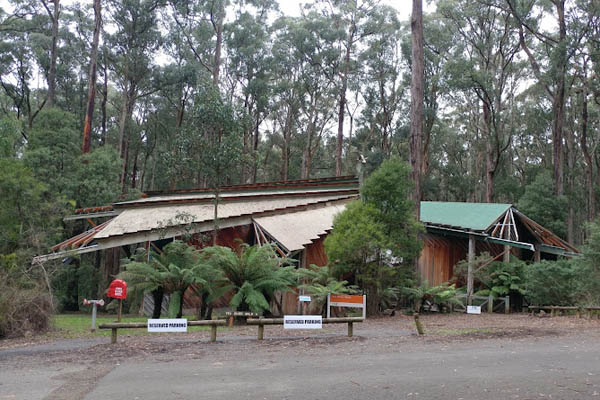
Toolangi Forest Discovery Centre
Probably mid-1990s
Source: M Leonard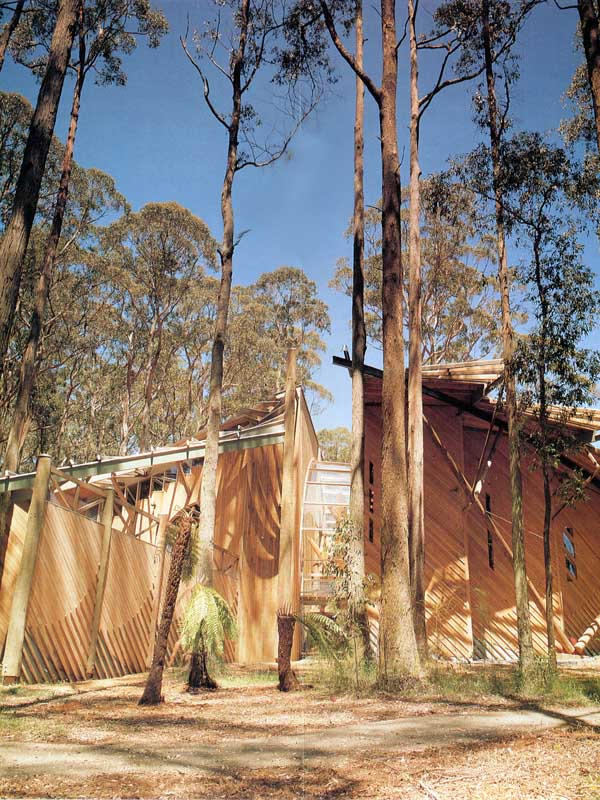
Toolangi Forest Discovery Centre
Probably mid-1990s
Source: J Cunningham
Footnotes
1 By the early 1980s Rod Incoll had convinced the Commission that the District needed a new office complex; the one subsequently constructed was, in-part, arguably the first purpose-built Community Education Centre the FCV had funded.
2 In the 1970s/80s this facility, owned and operated by Brighton Grammar School on leased State forest, saw students from all classes attending the Camp for six days at a time, and undertaking a graded progression through both outward-bound type activity, and forest-related studies. The Camp's manager, Bob Barrow, worked closely with District staff and, in many ways, developed a proto-type that a number of other schools were to emulate. Sadly, the BGS facility was destroyed by the 2009 Black Saturday bushfires.
3 Ministerial Foreword to the TIS.
4 Toolangi Forest Discovery Centre Concept Plan, Department of Conservation and Natural Resources, 1993.
5 Toolangi Forest Discovery Centre - by Steve Meacher. Accessed 3rd & 4th January 2023
6 Through the Education Reference Group, both FEP and the Toolangi Centre were promoted across the three school sectors. For several years the TFDC also had a small, independent staffed exhibit at the annual Melbourne Show.
7 "A co-operative venture involving the Commission, forest industries, Education Department and the Natural Resources Conservation League - has now entered its second year. The Project Officer is a teacher located within the Curriculum Branch of the Education Department. A comprehensive conceptual framework has been developed for the project and prototype curriculum materials are now being prepared for trials in schools ..." Source: FCV Annual Report 1983/84
See Also
Forest Education Project Resource Sheets 1998
Forest Changes, 1993
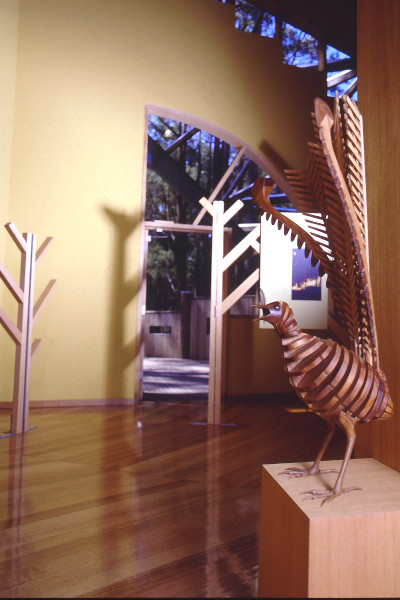
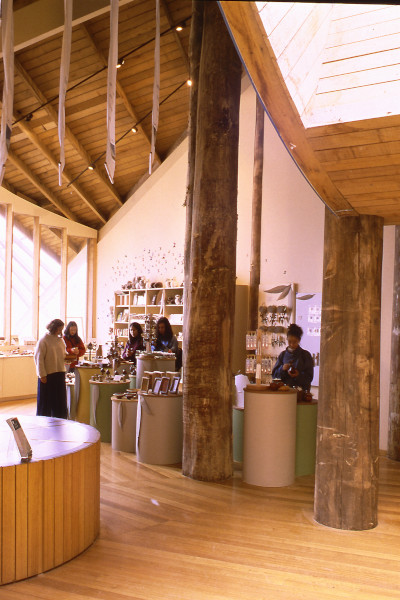
Toolangi Forest Discovery Centre
Early to mid-1990s
